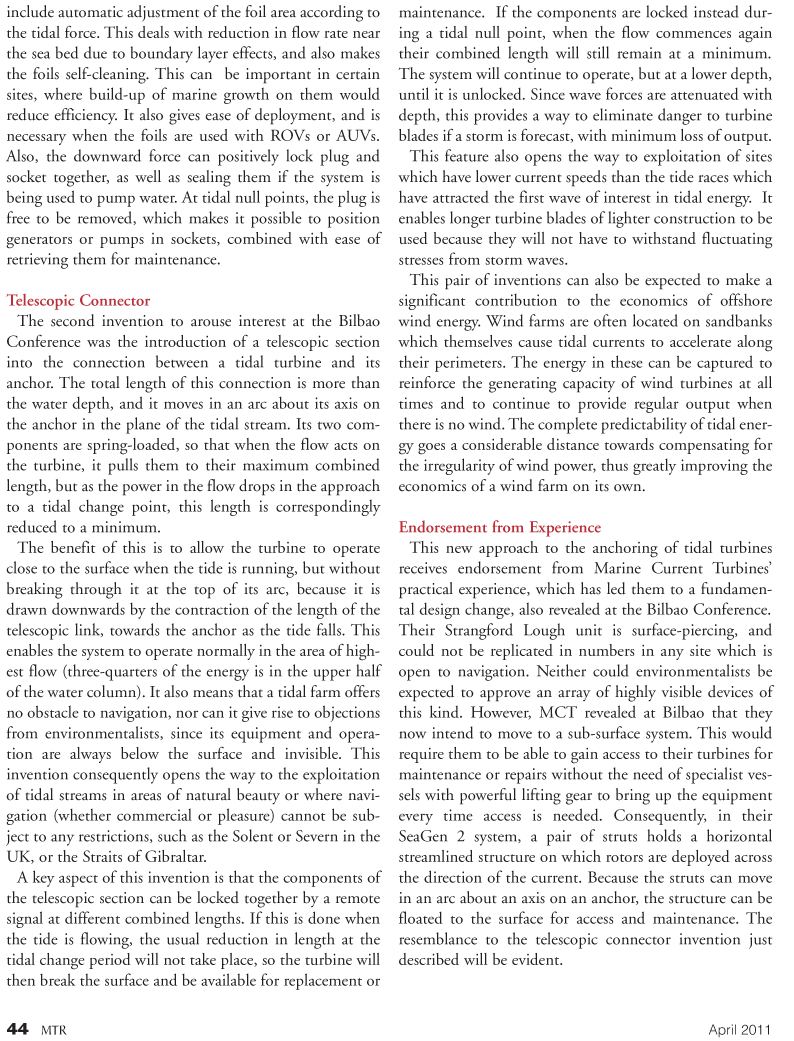
Page 44: of Marine Technology Magazine (April 2011)
Oil & Gas SubSea Monitoring
Read this page in Pdf, Flash or Html5 edition of April 2011 Marine Technology Magazine
include automatic adjustment of the foil area according to the tidal force. This deals with reduction in flow rate near the sea bed due to boundary layer effects, and also makes the foils self-cleaning. This can be important in certain sites, where build-up of marine growth on them would reduce efficiency. It also gives ease of deployment, and is necessary when the foils are used with ROVs or AUVs.
Also, the downward force can positively lock plug and socket together, as well as sealing them if the system is being used to pump water. At tidal null points, the plug is free to be removed, which makes it possible to position generators or pumps in sockets, combined with ease of retrieving them for maintenance.
Telescopic Connector
The second invention to arouse interest at the Bilbao
Conference was the introduction of a telescopic section into the connection between a tidal turbine and its anchor. The total length of this connection is more than the water depth, and it moves in an arc about its axis on the anchor in the plane of the tidal stream. Its two com- ponents are spring-loaded, so that when the flow acts on the turbine, it pulls them to their maximum combined length, but as the power in the flow drops in the approach to a tidal change point, this length is correspondingly reduced to a minimum.
The benefit of this is to allow the turbine to operate close to the surface when the tide is running, but without breaking through it at the top of its arc, because it is drawn downwards by the contraction of the length of the telescopic link, towards the anchor as the tide falls. This enables the system to operate normally in the area of high- est flow (three-quarters of the energy is in the upper half of the water column). It also means that a tidal farm offers no obstacle to navigation, nor can it give rise to objections from environmentalists, since its equipment and opera- tion are always below the surface and invisible. This invention consequently opens the way to the exploitation of tidal streams in areas of natural beauty or where navi- gation (whether commercial or pleasure) cannot be sub- ject to any restrictions, such as the Solent or Severn in the
UK, or the Straits of Gibraltar.
A key aspect of this invention is that the components of the telescopic section can be locked together by a remote signal at different combined lengths. If this is done when the tide is flowing, the usual reduction in length at the tidal change period will not take place, so the turbine will then break the surface and be available for replacement or maintenance. If the components are locked instead dur- ing a tidal null point, when the flow commences again their combined length will still remain at a minimum.
The system will continue to operate, but at a lower depth, until it is unlocked. Since wave forces are attenuated with depth, this provides a way to eliminate danger to turbine blades if a storm is forecast, with minimum loss of output.
This feature also opens the way to exploitation of sites which have lower current speeds than the tide races which have attracted the first wave of interest in tidal energy. It enables longer turbine blades of lighter construction to be used because they will not have to withstand fluctuating stresses from storm waves.
This pair of inventions can also be expected to make a significant contribution to the economics of offshore wind energy. Wind farms are often located on sandbanks which themselves cause tidal currents to accelerate along their perimeters. The energy in these can be captured to reinforce the generating capacity of wind turbines at all times and to continue to provide regular output when there is no wind. The complete predictability of tidal ener- gy goes a considerable distance towards compensating for the irregularity of wind power, thus greatly improving the economics of a wind farm on its own.
Endorsement from Experience
This new approach to the anchoring of tidal turbines receives endorsement from Marine Current Turbines’ practical experience, which has led them to a fundamen- tal design change, also revealed at the Bilbao Conference.
Their Strangford Lough unit is surface-piercing, and could not be replicated in numbers in any site which is open to navigation. Neither could environmentalists be expected to approve an array of highly visible devices of this kind. However, MCT revealed at Bilbao that they now intend to move to a sub-surface system. This would require them to be able to gain access to their turbines for maintenance or repairs without the need of specialist ves- sels with powerful lifting gear to bring up the equipment every time access is needed. Consequently, in their
SeaGen 2 system, a pair of struts holds a horizontal streamlined structure on which rotors are deployed across the direction of the current. Because the struts can move in an arc about an axis on an anchor, the structure can be floated to the surface for access and maintenance. The resemblance to the telescopic connector invention just described will be evident. 44 MTR April 2011

 43
43

 45
45
